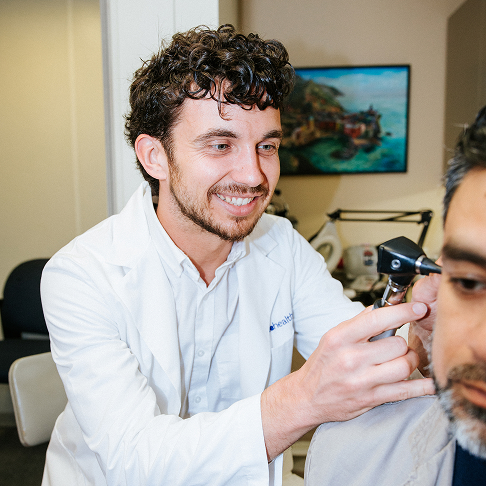Oftentimes hearing loss can be frustrating and isolating for the person experiencing it. As a friend or family member of someone struggling with hearing loss, there are some things you can do to help.
Step #1: Get A Proper Hearing Test
A proper hearing test is the foundation on which further treatment relies upon, as the results will often determine the course of treatment. Typically, getting a comprehensive hearing test requires visiting an ENT or audiology clinic, and consists of listening to soft beeps and repeating words. However, another option is to take an online hearing test—such as the one offered by Treble Health—in order to get a general sense of the extent of hearing loss, which can then be further supported by an in-person test.
Step #2: Determine Whether You Need A Hearing Aid
Most hearing losses can be properly addressed and treated with hearing aids. It can often be overwhelming to decipher which hearing aid is best for you, so we recommend seeking professional help in order to determine your hearing needs. You may wish to look into securing a hearing aid evaluation from an audiology or ENT clinic.
Step #3: Reduce Background Noise
Many of the problems that stem from hearing loss are often exacerbated by the presence of background noise in settings such as crowded restaurants and group gatherings. By reducing background noise, it becomes easier for your brain to pick out and focus on sounds.
One way of monitoring background noise is to use an app like the NIOSH Sound Level Meter app, which gives you a decibel reading of any environment. Our advice would be to tread carefully in 60+ decibel environments, which may pose hearing difficulties. You may need to request a different table around the noisy area of the restaurant, or chose outdoor seating if it’s quieter.
In situations where you have more control over the environment, you can better handle background noise by changing the room’s acoustics. For example, if there’s a room in your house that creates a lot of reverberation and makes it more difficult to hear, you can dampen reverberation by hanging up fabrics or rugs. Improving lighting in the room is also helpful in aiding in communication.
Step #4: Adopt New Communication Strategies
When someone is struggling with hearing loss, they may not acknowledge that they haven’t heard something. Thus, it’s important to consider communication repair strategies, which can be as simple as asking them if they heard what you said. Use verbal signals, such as using the name of the individual with hearing loss, in order to make it apparent that you intend to talk to them.
Another communication strategy is to move closer to the sound source and decrease the distance between whomever you are speaking with, in order to avoid succumbing to background noise.
Step #5: Use Hearing Assistive Devices
In addition to hearing aids, there are many other devices that can help those who are struggling with hearing loss. Hearing aids are considered a global solution, and there are still certain environments—like a busy restaurant—that can obscure sound. In these kinds of environments, adding a microphone accessory might help considerably, as it would allow for a microphone to be selectively placed in order to support hearing of an entire conversation.
Other assistive accessories include TV hearing systems (like TV Ears)—which allows those with hearing loss to listen to the TV at their own preferred volume without disturbing others—and phone captioning systems, which amplify and caption phone conversations and voicemails.
What To Do Next For Hearing Loss
At Treble Health, we know the importance of finding the right hearing aids to suit your ears and your lifestyle. We put together a consumer guide to help you find the best hearing aids on the market so you can live a full life without having to worry about hearing loss. Click here to get the free Hearing Aids in 2022: Consumer Guide.
Want to speak with an expert audiologist about hearing aids instead? At the tap of a finger, you can schedule a free Hear From Home™ telehealth consultation today! You’ll be connected with a real audiologist, not a salesperson, and there is no obligation or commitment.














